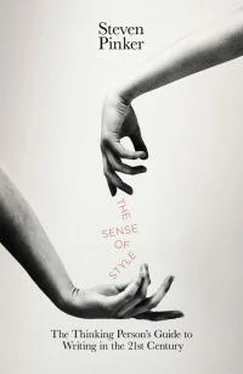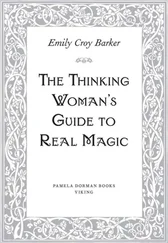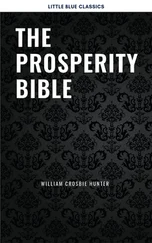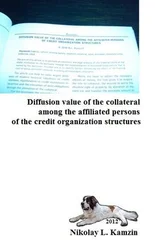When a negative element has wide scope (that is, when it applies to the whole clause), it is not literally ambiguous, but it can be maddeningly vague. The vagueness lies in the focus of the negation—which phrase the writer had in mind as falsifying the whole sentence. Take the sentence I didn’t see a man in a gray flannel suit. It could mean:
I didn’t see him; Amy did.
I didn’t see him; you just thought I did.
I didn’t see him; I was looking away.
I didn’t see him; I saw a different man.
I didn’t see a man in a gray suit; it was a woman.
I didn’t see a man in a gray flannel suit; it was brown.
I didn’t see a man in a gray flannel suit; it was polyester.
I didn’t see a man in a gray flannel suit; he was wearing a kilt.
In conversation, we can stress the phrase we wish to deny, and in writing we can use italics to do the same thing. More often, the context makes it clear which affirmative statement was plausible in the first place, and hence which one the writer is going to the trouble of denying. But if the subject matter is unfamiliar and has many parts, and if the writer doesn’t set the reader up by focusing on one of those parts as a fact worth taking seriously, the reader may not know what he should no longer be thinking. That is the problem with Keegan’s puzzling speculation about the multipart thought that Clausewitz and Aristotle dared not confront, that man is a thinking animal in whom the intellect directs the urge to hunt and the ability to kill: were they spooked by the possibility that man thinks, that he’s an animal, or that he thinks about hunting and killing?
Now let’s give Keegan a chance to explain the thought. He does so in the book’s second paragraph, which I’ll use to illustrate, by its absence, another principle of coherence—a sense of proportion:
This is not an idea any easier for modern man to confront than it was for a Prussian officer, born the grandson of a clergyman and raised in the spirit of the eighteenth-century Enlightenment. For all the effect that Freud, Jung and Adler have had on our outlook, our moral values remain those of the great monotheistic religions, which condemn the killing of fellow souls in all but the most constrained circumstances. Anthropology tells us and archaeology implies that our uncivilised ancestors could be red in tooth and claw; psychoanalysis seeks to persuade us that the savage in all of us lurks not far below the skin. We prefer, none the less, to recognise human nature as we find it displayed in the everyday behaviour of the civilised majority in modern life—imperfect, no doubt, but certainly cooperative and frequently benevolent. Culture to us seems the great determinant of how human beings conduct themselves; in the relentless academic debate between “nature and nurture,” it is the “nurture” school which commands greater support from the bystanders. We are cultural animals and it is the richness of our culture which allows us to accept our undoubted potentiality for violence but to believe nevertheless that its expression is a cultural aberration. History lessons remind us that the states in which we live, their institutions, even their laws, have come to us through conflict, often of the most bloodthirsty sort. Our daily diet of news brings us reports of the shedding of blood, often in regions quite close to our homelands, in circumstances that deny our conception of cultural normality altogether. We succeed, all the same, in consigning the lessons both of history and of reportage to a special and separate category of “otherness” which invalidate our expectations of how our own world will be tomorrow and the day after not at all. Our institutions and our laws, we tell ourselves, have set the human potentiality for violence about with such restraints that violence in everyday life will be punished as criminal by our laws, while its use by our institutions of state will take the particular form of “civilised warfare.” 27
I think I see what Keegan is getting at—humans have innate impulses toward violence, yet today we try to deny it—but the momentum of his presentation pushes in the other direction. Most of this passage says the opposite: that we couldn’t help but be aware of humanity’s dark side. Keegan loads us up with reminders of the dark side, including Freud, Jung, Adler, anthropology, archaeology, psychoanalysis, the savage in all of us, our undoubted potentiality for violence, history lessons about conflict, bloodthirsty violence, our daily diet of news, reports of the shedding of blood, the human potentiality for violence, and violence in everyday life. The reader starts to think, Who is this “we” who fail to appreciate them?
The problem here is a lack of balance, of proportionality. An important principle in composition is that the amount of verbiage one devotes to a point should not be too far out of line with how central it is to the argument. If a writer believes that 90 percent of the evidence and argument supports a position, then something like 90 percent of the discussion should be devoted to the reasons for believing it. If a reader is spending only 10 percent of his time on why it’s a good idea, and fully 90 percent on why he might reasonably think it’s a bad idea—while the writer insists all along that it really is a good idea—then the reader’s mounting impressions will be at cross-purposes with the author’s intent. The author then must furiously try to minimize what she has been saying, which only arouses the reader’s suspicions. Keegan tries to dig himself out from under his own heap of counterevidence by repeatedly issuing pronouncements about what an unidentified “we” stubbornly and defensively believe—which only prompts the reader to think, “Speak for yourself!” The reader gets the feeling that he’s being bullied rather than persuaded.
Of course, responsible writers have to deal with counterarguments and counterevidence. But if there are enough of them to merit an extended discussion, they deserve a section of their own, whose stated point is to examine the contrary position. A fair-minded examination of the counterevidence can then occupy as much space as it needs, because its bulk will reflect its importance within that section. This divide-and-conquer strategy is better than repeatedly allowing counterexamples to intrude into the main line of an argument while browbeating readers into looking away.
After a page-long digression on pacifism, Christianity, and the Roman Empire, Keegan returns to what is wrong with Clausewitz’s dictum and with the modern understanding of war it captures. The passage will help us appreciate a third principle of text-wide coherence:
[Clausewitz’s dictum] certainly distinguished sharply between the lawful bearer of arms and the rebel, the freebooter and the brigand. It presupposed a high level of military discipline and an awesome degree of obedience by subordinates to their lawful superiors. … It assumed that wars had a beginning and an end. What it made no allowance for at all was war without beginning or end, the endemic warfare of non-state, even pre-state peoples, in which there was no distinction between lawful and unlawful bearers of arms, since all males were warriors; a form of warfare which had prevailed during long periods of human history and which, at the margins, still encroached on the life of civilised states and was, indeed, turned to their use through the common practice of recruiting its practitioners as “irregular” light cavalry and infantrymen. … During the eighteenth century the expansion of such forces—Cossacks, “hunters,” Highlanders, “borderers,” Hussars—had been one of the most noted contemporary military developments. Over their habits of loot, pillage, rape, murder, kidnap, extortion and systematic vandalism their civilised employers chose to draw a veil. 28
Читать дальше












